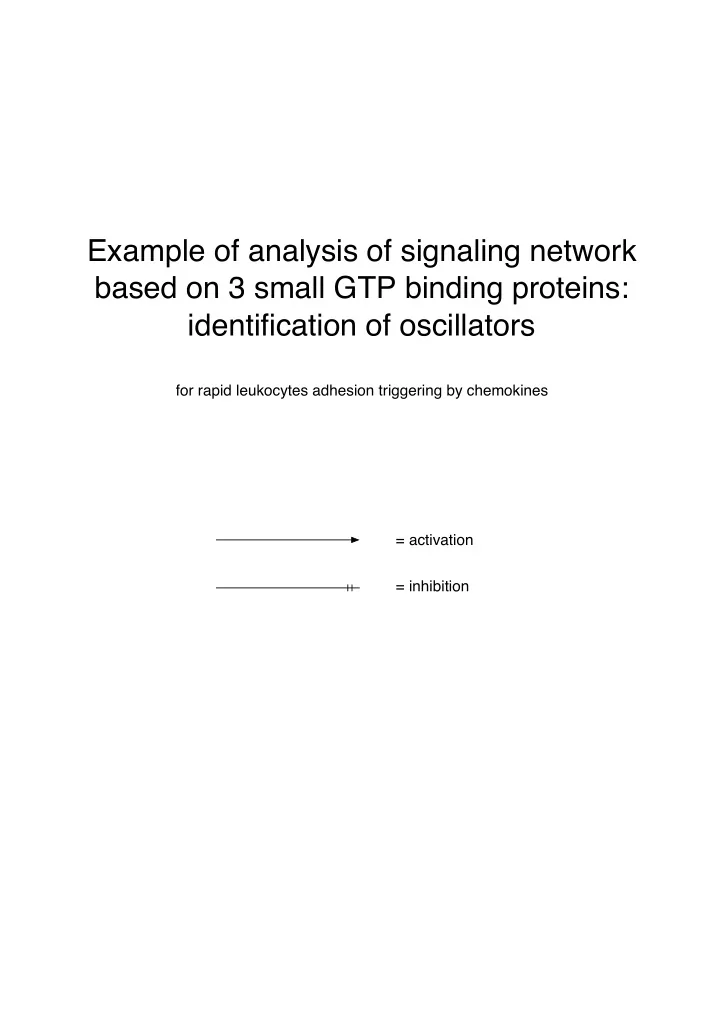

Example of analysis of signaling network based on 3 small GTP binding proteins: identification of oscillators for rapid leukocytes adhesion triggering by chemokines = activation = inhibition
Level 1 RhoA zPKC PDK1 PKB 2-molecules zPKC Mek PKB Raf1 Mek ERK H-ras z PKC PLD zPKC RhoA PLD RhoA Raf1 Rac1 zPKC Rac1 PI(3)K PKB Raf1 zPKC PKB Rac1 Pak Pak Raf1 PKB Rac1 H-ras Raf1 Raf1 Mek Mek ERK H-ras PI(3)K PI(3)K PDK1
Level 2 pathway + PLD zPKC RhoA _ Raf1 Mek ERK A + zPKC Rac1 B _ Pak Raf1 _ Raf1 Mek ERK H-ras C + PI(3)K PDK1 PKB
Level 3 network A + PLD zPKC RhoA _ Raf1 Mek ERK _ Raf1 Mek ERK H-ras C + PI(3)K PDK1 PKB + zPKC Rac1 Pak Raf1 _ B
switch on A B switch off A B by-stable (memory) A B negative feedback A B B bifurcation A (non linearity-thresholding) c
+ = no signal A B A B (futile circuit) B A + = c C B B A oscillator c B + = A B A c B memory oscillator A c
Raf1 = H-ras bifurcation H-ras PI(3)K Raf1 = Raf1 oscillator H-ras PI(3)K PDK1 PKB zPKC Mek ERK H-ras PI(3)K PDK1 PKB Raf1 = PDK1 bifurcation + PKB oscillator zPKC = transient z PKC Rac1 activation PKB
zPKC Rac1 PKB Raf1 PI(3)K PDK1 = rac1 bifurcation + rac1/PI(3)K by-stable circuit + PKB oscillator + rac1 oscillator
zPKC Mek ERK H-ras PI(3)K PDK1 PKB Raf1 + zPKC Rac1 PKB Raf1 PI(3)K PDK1 Rac1 zPKC Mek ERK H-ras PKB PI(3)K PDK1 Raf1 rac1 bifurcation + PI(3)K bifurcation + H-ras bifurcations + PDK1 bifurcation + rac1 / PI(3)K by-stable circuit + rac1 oscillator + PKB oscillator + Raf1 oscillator
Rac1 zPKC Mek ERK H-ras PKB PI(3)K PDK1 Raf1 Oscillatory output (frequency, amplitude, duration) Phenomenon
Examples of oscillatory behavior in biology Menstrual cycle Circadian rhythm Neutrophil chemotaxis NADPH-oxidase activation Protease release by PMNs during chemotaxis iCa2+movement
Agonist n bifurcations + n by-stable circuits + n negative feedbacks + n oscillators, etc. Phenomenon
C A Oscillation-independent B Oscillation-dependent (frequency, amplitude, duration) C A Oscillation-independent B Oscillation-dependent C A Oscillation-independent B Oscillation-dependent C A Oscillation-independent specificity B Oscillation-dependent
Experimental data Computer modeling (signaling molecules are treated just as logic units) Identification of overall organization of the system (signaling networks are treated as logic circuits) Computer experiment Prediction of pharmacological effect
Recommend
More recommend